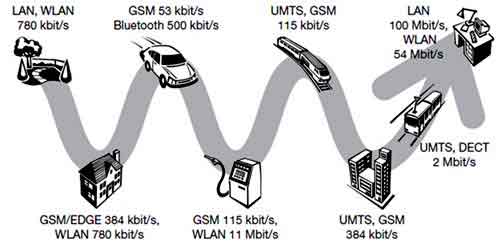Introduction to Mobile Communications and Computing
Sakshi Education

1) Introduction:
The raise of societal dynamics standards process has been catalyzed by the communication field. With the invention of the telephone, communication from one end of the world to the other end started happening clearing the distance hurdle, but as these are wired communication systems portability has been a big issue. Invention of mobile or wireless networks, people can communicate any one from anyplace provided the base station exists. With advent of smart phones, mobile communications have broadened their scope to greater extent.
2) History of mobile communications:
1. Past
3.1 Cellular topology:
1. 1950 ´s, cellular network concept
2. 1971, Finland, ARP, first public commercial cellular, mobile network
3.2 1st Generation: Analogue, Frequency Division Multiplexing
Higher loss-rates due to interference
1. User Mobility: User mobility refers to mechanism where users communicate “anytime, anywhere, with anyone” on the same telecommunication network.
Example: Let’s take simple call-forwarding solutions known from the telephone or computer desktops supporting roaming
2. Device Portability: Device portability ensures that communication doesn’t disturb even if the device is moving.
Example: At times when device move from one signal coverage region(base station) to other region, then if the system handles by its own even if the device moves from a base station to the next base station. This we term as device portability.
Mobility Issues:
1. Vehicles:
Like mobile phones transformed in to smart phones, even cars have transformed to smart cars, where cars are equipped with all accessories as in smart phones. Mobile communications comes very much handy for transmission of news, road condition,
weather, music via digital audio broadcasting (DAB). GPS system in cars helps Keep in context of road accidents, mobile communication applications will be very handy in to handling accidents This will for revolutionize transportation field maintenance, as position via GPS. The local ad-hoc network with vehicles close-by to prevent accidents, guidance system, and redundancy vehicle data can be transmitted in advance for maintenance
Figure 1.1: A typical application of mobile communications: road traffic
2. Emergencies
We have heard many cases where patients die while taking patient in ambulance to hospital. This issue can be solved by early transmission of patient data to the hospital, current status, first diagnosis can be done and safety measures can be taken so resist the patient life till he reaches the hospital. A wireless network in particular adhoc wireless networks comes very handy during natural disasters.
3. Business:
In Business, the business executives need to travel to meet clients, so it is required for them to have direct access to customer files stored in a central location consistent databases and updated information about the business. Here wireless networks serves like a mobile office.

Figure 1.2: Mobile and wireless services – always best connected
7) Effects of device portability
Power consumption
Wireless Communication
The raise of societal dynamics standards process has been catalyzed by the communication field. With the invention of the telephone, communication from one end of the world to the other end started happening clearing the distance hurdle, but as these are wired communication systems portability has been a big issue. Invention of mobile or wireless networks, people can communicate any one from anyplace provided the base station exists. With advent of smart phones, mobile communications have broadened their scope to greater extent.
2) History of mobile communications:
1. Past
- Fire signal signals used to communicate the fall of Troy to Athens
- In 2nd century B.C., sets of torches to transmit characters
- 1793, 3 part semaphores on top hills and towers
- 1837, electric telegraph
- 1895, first radio transmission 29 km away
- 1906, amplitude-modulated (AM) radio.
- 1920, broadcast of radio news program
- 1928, TV broadcast trials
- 1933, frequency-modulated (FM) radio
- 1946, Swedish police had the first radio phones in stalled in cars
- 1950, mobile phone with direct dialing
3.1 Cellular topology:
1. 1950 ´s, cellular network concept
- power of transmitted signal falls with square of distance
- 2 users can operate on same frequency at separate locations
2. 1971, Finland, ARP, first public commercial cellular, mobile network
3.2 1st Generation: Analogue, Frequency Division Multiplexing
- 1982, NMT network covering Finland/Sweden/Norway/Denmark
- 1983, AMPS in America
- 1985, TACS, Total Access Communications Service, in Europe
- 1971, ALOHANET packet radio
- computers communicate with central HUB
- 1980's ad-hoc, self-configurable packet networks
- 1980's ad - hoc, self - configurable packet networks
- 1985, Wireless LANs authorized to use ISM bands
- 1997, first WLAN standard
- 1982, specification GSM is started
- Early 1990 ´s
- Europe: GSM
- USA: D-AMPS, CDMAONE
- Japan: Personal Digital Cellular (PDC)
- In 2001, Japan, first implementation of 3G systems
Higher loss-rates due to interference
- emissions of, e.g., engines, lightning
- frequencies have to be coordinated, useful frequencies are almost all occupied Low transmission rates
- local some Mbit/s, regional currently, e.g., 9.6kbit/s with GSM .Higher delays, higher jitter
- connection setup time with GSM in the second range, several hundred milliseconds for other wireless systems
- radio interface accessible for everyone, base station can be simulated, thus attracting calls from mobile phones
- secure access mechanisms important
1. User Mobility: User mobility refers to mechanism where users communicate “anytime, anywhere, with anyone” on the same telecommunication network.
Example: Let’s take simple call-forwarding solutions known from the telephone or computer desktops supporting roaming
2. Device Portability: Device portability ensures that communication doesn’t disturb even if the device is moving.
Example: At times when device move from one signal coverage region(base station) to other region, then if the system handles by its own even if the device moves from a base station to the next base station. This we term as device portability.
Mobility Issues:
- Bandwidth restrictions and variability
- Location-aware network operation
- User may wake up in a new environment
- Dynamic replication of data
- Querying wireless data & location-based responses
- Busty network activity during connections & handling disconnections
- Disconnection
- OS and File System Issues - allow for disconnected operation
- Database System Issues - when disconnected, based on local data
- Battery power restrictions
- Risks to data
- Physical damage, loss, theft
- Unauthorized access
- encrypt data stored on mobiles
- Backup critical data to fixed (reliable) hosts
- Small user interface
- Small displays due to battery power and aspect ratio constraints
- Cannot open too many windows
- Difficult to click on miniature icons
- Input - Graffiti, (Dictionary-based) Expectation
- Gesture or handwriting recognition with Stylus Pen Voice matching or voice recognition
1. Vehicles:
Like mobile phones transformed in to smart phones, even cars have transformed to smart cars, where cars are equipped with all accessories as in smart phones. Mobile communications comes very much handy for transmission of news, road condition,
weather, music via digital audio broadcasting (DAB). GPS system in cars helps Keep in context of road accidents, mobile communication applications will be very handy in to handling accidents This will for revolutionize transportation field maintenance, as position via GPS. The local ad-hoc network with vehicles close-by to prevent accidents, guidance system, and redundancy vehicle data can be transmitted in advance for maintenance
Figure 1.1: A typical application of mobile communications: road traffic
2. Emergencies
We have heard many cases where patients die while taking patient in ambulance to hospital. This issue can be solved by early transmission of patient data to the hospital, current status, first diagnosis can be done and safety measures can be taken so resist the patient life till he reaches the hospital. A wireless network in particular adhoc wireless networks comes very handy during natural disasters.
3. Business:
In Business, the business executives need to travel to meet clients, so it is required for them to have direct access to customer files stored in a central location consistent databases and updated information about the business. Here wireless networks serves like a mobile office.

Figure 1.2: Mobile and wireless services – always best connected
7) Effects of device portability
Power consumption
- limited computing power, low quality displays, small disks due to limited battery capacity
- CPU: power consumption ~ CV2f
- C: internal capacity, reduced by integration
- V: supply voltage, can be reduced to a certain limit
- f: clock frequency, can be reduced temporally
- higher probability, has to be included in advance into the design (e.g., defects, theft)
- compromise between size of fingers and portability
- integration of character/voice recognition, abstract symbols
- limited value of mass memories with moving parts
- Flash-memory or? as alternative
Wireless Communication
- transmission quality (bandwidth, error rate, delay)
- modulation, coding, interference
- media access, regulations
- location dependent services
- location transparency
- quality of service support (delay, jitter, security)
- power consumption
- limited computing power, sizes of display, ...
- usability
Published date : 20 May 2015 04:42PM






